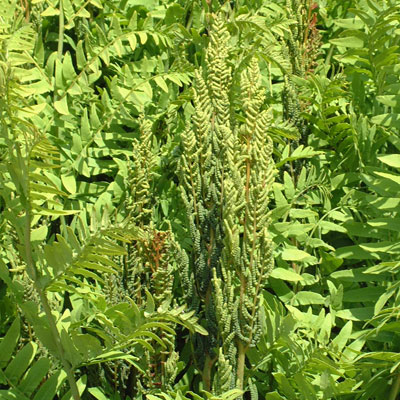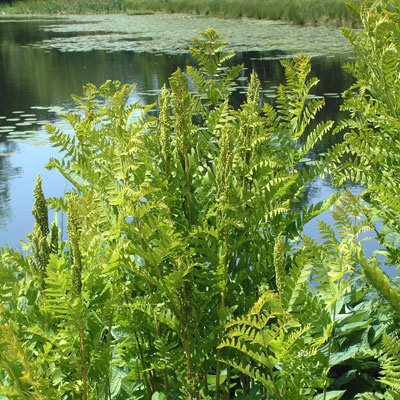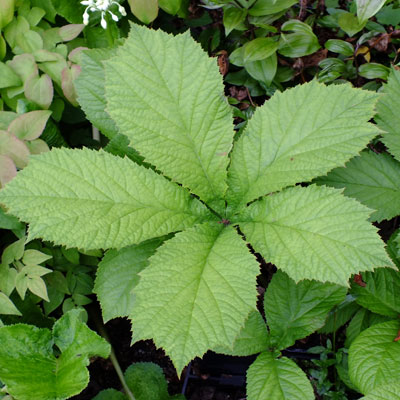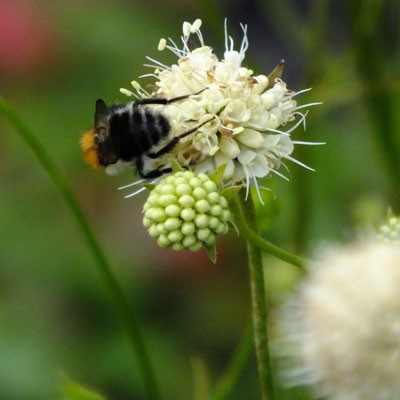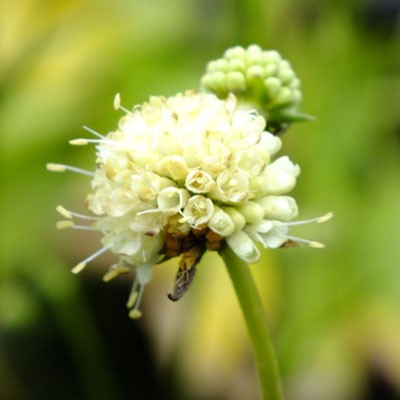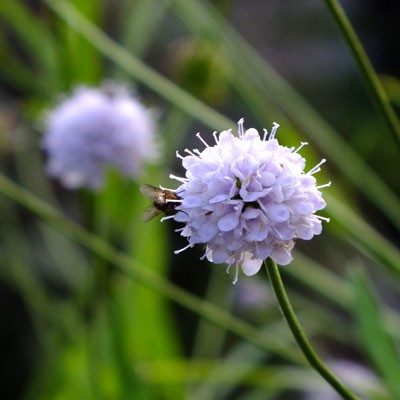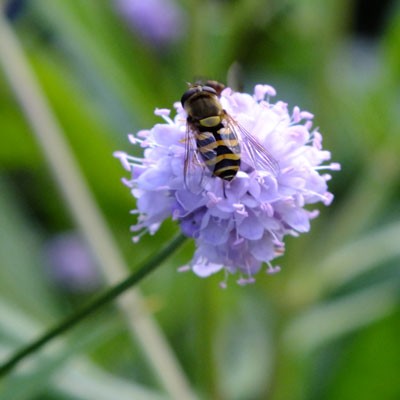-
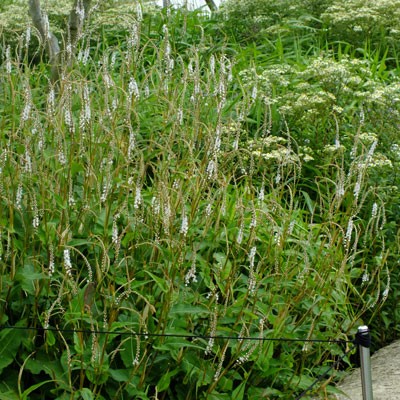
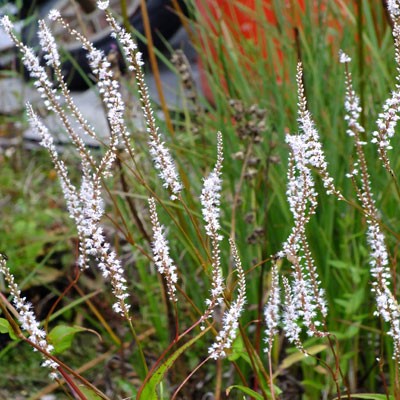
Potsize - 1L
This is one of those plants that has really surprised us by how much we like it. It comes from a fairly robust genus where elegance is not usually the order of the day, but it really is a thing of great refinement. In habit it is fairly open and quite large growing at least 1m in each direction. The stems branch widely with each node bearing a long tapered leaf whose edge colours red, a colour that repeats into the long tapering flowering stems which are narrow and carry small starry white flowers which point and twist like those fireworks that whizz as they are sent skywards. An undemanding plant for a moist to wet soil and a must for the flower arranger. Good with Euphorbia 'Fireglow' or Schizostylis coccinea ''Major' Discount of 25p per plant for quantities of 3 or overLinks
Botanical Style Photographs
-

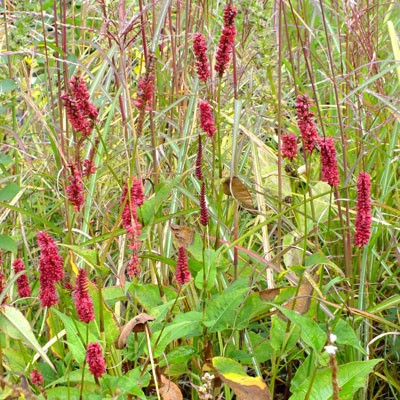
Potsize - 1L
A recent addition to the range of Persicaria, being one of the darkest to date. Flowers are produced over a very long season in a rich deep congealed blood red. Height between 80 and 120 cm. A firm favourite of our good friend Dinah, and she knows a thing or two about Persicarias. Very drought tolerant. Discount of 25p per plant for quantities of 3 or overLinks
Botanical Style Photographs
-


Potsize - 1L
Long spikes of Rose Madder buds, opening in narrow sections to a salmon pink flower to give a striking banded effect. A little earlier than some into flower from mid summer onwards into Early Autumn. Bred by Belgian Persicaria breeder Chris Ghyselen. 120cm in height. Good in a wide variety of soils providing it doesn't get too dry. Discount of 25p per plant for quantities of 3 or overLinks
Botanical Style Photographs
-

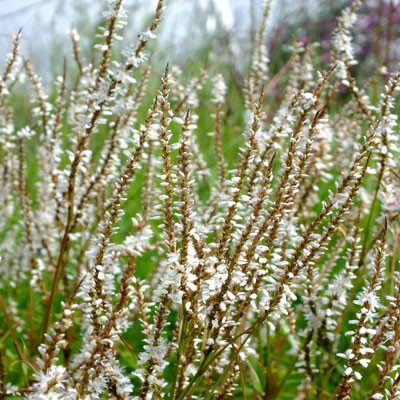
Potsize - 1L
This is one of the many varieties bred by the Belgian Landscape designer Chris Ghyselen. It is like a shorter, more floriferous form of P.amplexicaule Alba, growing 90-120cm in height. The leaves are long and pointed, forming an attractive feature on their own. July to October. for sun to part shade. Discount of 25p per plant for quantities of 3 or overLinks
Botanical Style Photographs
-
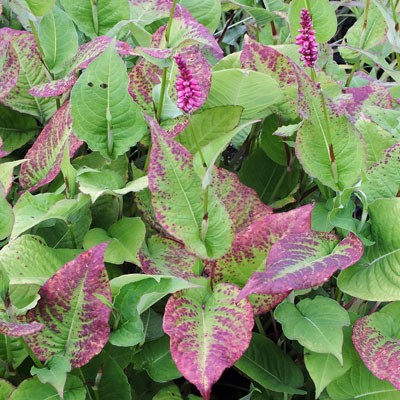
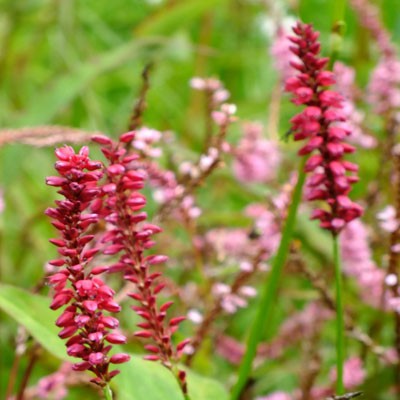
Potsize - 1L
This variety was a chance seedling identified by Alan Bloom. It is shorter than the species with an extended flowering season all the way from July through to November. The flowers are a rich magenta pink with electric blue stamens. Height 100cm (sometimes more) by 70cm wide. Very drought tolerant. Discount of 25p per plant for quantities of 3 or overLinks
Botanical Style Photographs
-
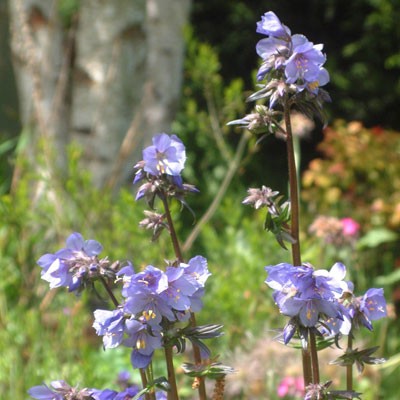

Potsize - 1L
Polemonium yezoense var. hidakanum 'Purple Rain'. Beautiful Jacob's Ladder with fine filigree foliage, tinted purple and surmounted by an abundance of cobalt-blue flowers. Excellent at the edge of any bed. Grows best in sun. 50cm. The colour of the foliage is stronger in cooler weather and in brighter locations. Cut the spent flower stems hard back to rejuvenate the plant and enjoy a second flush of flowers. Avoid very dry locations which will leave the plants more vulnerable to mildew.Discount of 25p per plant for quantities of 3 or overLinks
Polemonium Compared
-

Potsize - 1L
This form of Polypody is quite close in appearance to P.cambricum but is larger with broader fronds up to 40cm in size. It is slow to increase but will form reliable adaptable ground cover in time. Evergreen, producing the new fronds in late Summer which persist through to Spring. Discount of 25p per plant for quantities of 3 or overLinks
Ferns - Garden Pictures
Ferns for Moist Sites
Ferns for Dry Sites
Ferns - Deciduous or Evergreen
Botanical Style Photographs
-
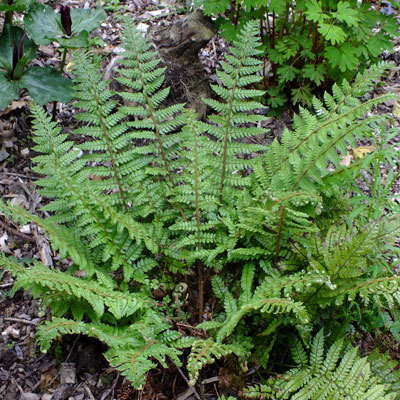

Potsize - 1L
Makino's Holly Fern. A lovely evergreen, modestly sized fern with a real tidy beauty to it. The fronds are a rich deep green with a nice shine. for a humus rich soil. 45-75cm tall. I think of this as the mid sized member of 3 similar ferns (P.tsus-sumense, P.makinoi and P.rigens)Discount of 25p per plant for quantities of 3 or overLinks
Ferns - Garden Pictures
Ferns for Moist Sites
Ferns for Dry Sites
Ferns - Deciduous or Evergreen
Botanical Style Photographs
-
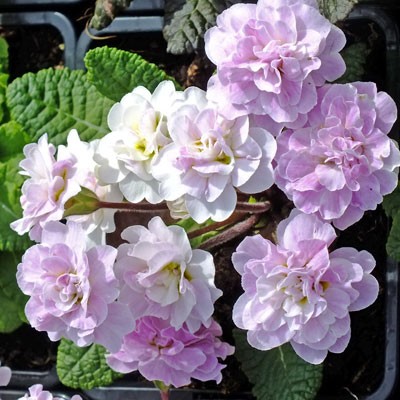

Potsize - 1L
Delightful frilly double primroses open creamy white and quickly develop a suffused fleckled pink glow which is strongest on the outermost petals. The central petals have a hint of lemon at the base. As it is sterile it flowers over a v ery long seasonn from late Autumn into early Summer. A sweet little poppet.Discount of 25p per plant for quantities 3 or over or for any 10 from the 'Higly Bred Primula' categoryLinks
Primula Compared
-
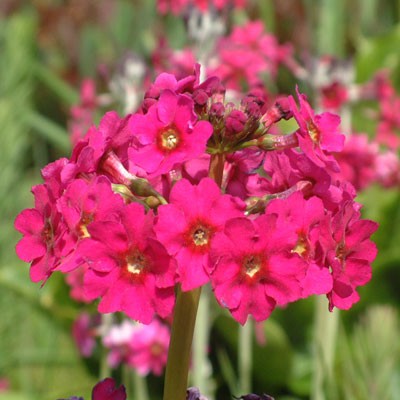

Potsize - 9cm
Primula japonica 'Carminea'. Easily grown sturdy candelabra primulas with strong stems baring up to six dazzling tiers of the deepest cerise primrose flowers. For rich moisture retentive soils. Best grown in shade or partial shade to avoid the sun fading the flowers. Flowers in May and June. >Discount of 30p per plant for quantities of 3 -9, 50p for 10 or overLinks
Primula Compared
-
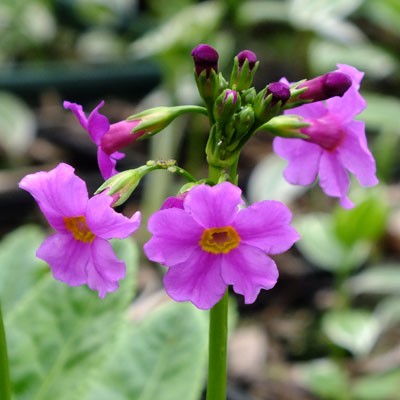
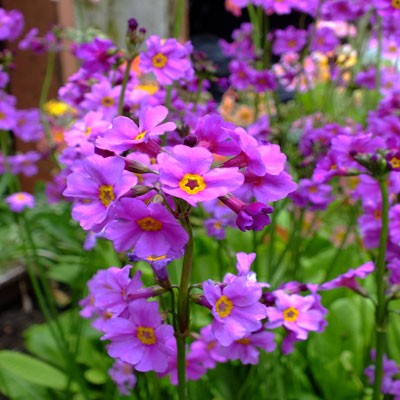
Potsize - 9cm
Primula poissonii. An easily grown Chinese species, not as tall or chunky as some of the more common Candelabra primulas, but quickly forming good clumps of evergreen bluish foliage up to 20cm high. The flower stems are about 30cm high and display the whorls of up to 10 deep magenta, yellow eyed flowers to great effect. Ideal for moisture retentive soils in shade or damper conditions in more sun. >Discount of 30p per plant for quantities of 3 -9, 50p for 10 or overLinks
Primula Compared
-
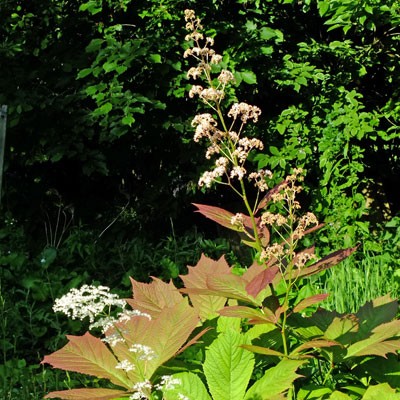
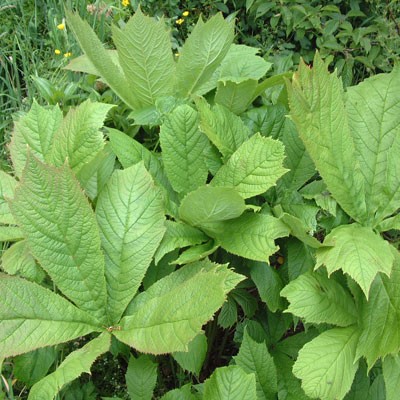
Potsize - 1L
This variety is a cross made between R.aesculifolia and R.podophylla by Eric Smith and Jim Archibald at the Plantsman Nursery. The leaves are like R.podophylla except that they are longer in each segment relative to the width and larger overall. The ends of the leaves escecially will take on red tones during the Summer months, more so than R.podophylla under the same conditions. The impressive flower spike is tall, creamy white and columnar.Links
Botanical Style Photographs
-
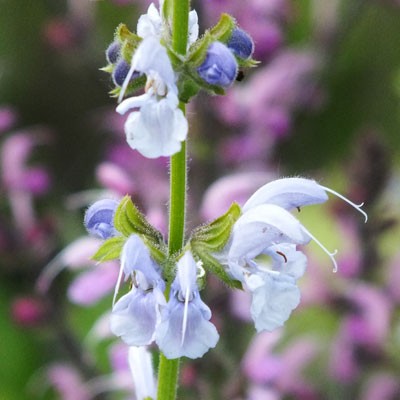
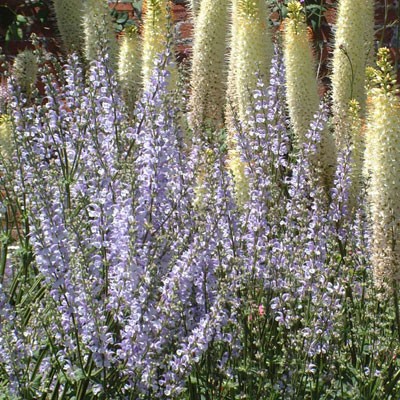

Bee Friendly
Potsize - 1L
A sky blue version of these lovely large flowered, perennial salvias. First flowering starts in june and July, but if dead-headed flowers for a second time in September. 50 cm. Border Ballet series.Discount of 25p per plant for quantities of 3 or overLinks
Salvia Compared
Botanical Style Photographs
-
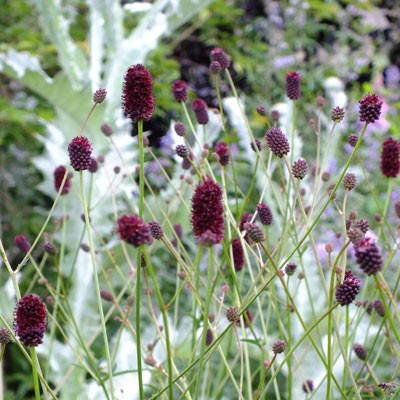

Potsize - 1L
Sanguisorba 'Chocolate Tip'. All the wow factor of 'Arnhem' and its smart little flowers but on a more modest scale of plant. The foliage still makes a luxurious mound but is finer in all its aspects than either 'Arnhem' or menziesii and shows a red midrib. The flowers are perhaps a shade darker and the flowering stems are plentiful and rise about 3 feet. It manages to make a statement in the border without adding too much weight.Links
Botanical Style Photographs
-
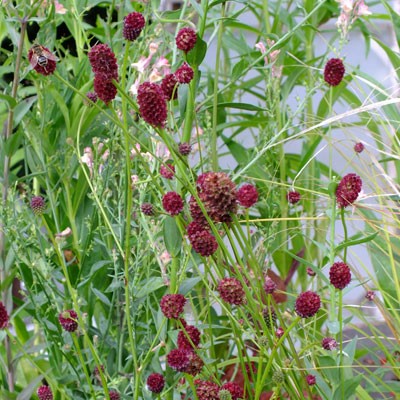
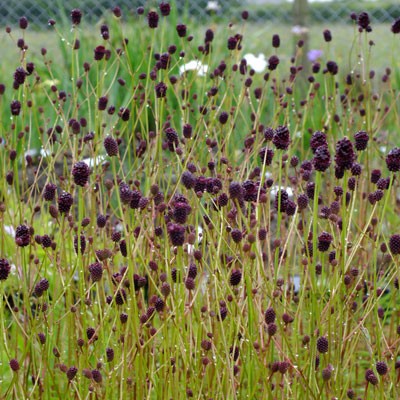
Potsize - 1L
A very useful dwarf selection of these interesting perennials. Mounds of finely divided attractive foliage are covered with dark burgundy cone flowers, all carried on wiry stems 30cm high in mid-summer. Makes a great edging plant or architectural vertical accent in short planting schemes. Super cut flower. Sun to Partial shade, any soil that is not too dry. Discount of 25p per plant for quantities of 3 or overLinks
Botanical Style Photographs
-

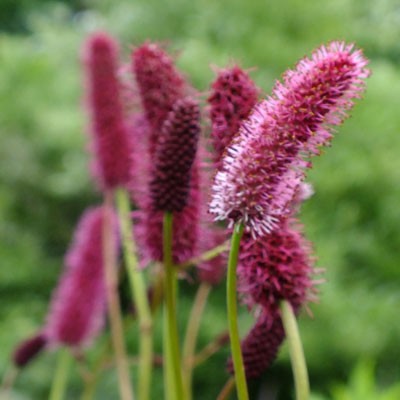
Potsize - 1L
Sanguisorba menziesii. An unusual and rather special plant for the summer border. Lovely mounds of dissected and smartly toothed grey-green leaves emerge early and act as a valuable foil for Spring bulbs. Then in June it sends up lots of long wiry self-supporting stems, each crowded with neat, almost cone-like flowers, each tightly packed with dried blood red florets which then erupt into shaggy pink foxtails. Makes an interesting focal point and especially good as a cut flower.Links
Botanical Style Photographs
-

Potsize - 1L
This is a fairly new variety. What distinguishes it is its dense, rounded habit and particularly large flower heads which are long and narrow and a deep rich congealed blood red. 100cm in flower, July to September.Links
Botanical Style Photographs
-
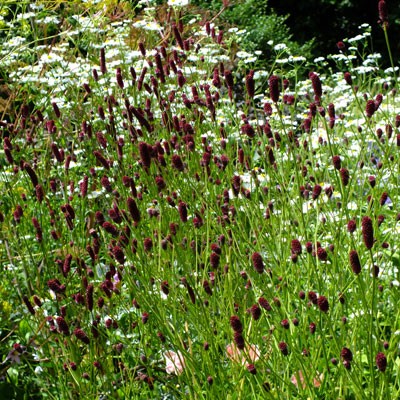
Potsize - 1L
Like a half sized, shorter version of Sanguisorba 'Arnhem', this lovely sanguisorba sports waving heads of raspberry red cone-like flowers on stiff stems above pinnatifid foliage. For full sun but not too dry borders. Flowering in mid Summer. Korea. 4 feet high.Discount of 25p per plant for quantities of 3 or overLinks
Botanical Style Photographs
-
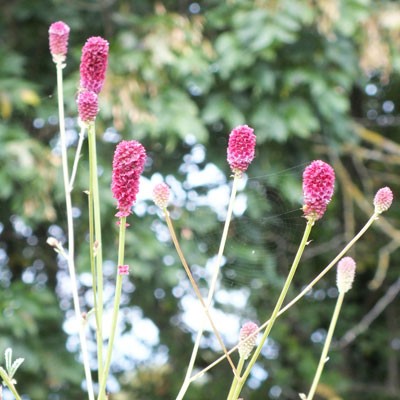
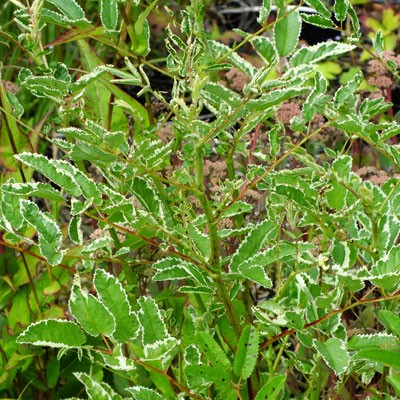
Potsize - 1L
The leaves are sea-green, very like the leaves of our native Rowan in shape, with delicately crimped edges picked out in a bright cream. It isn't an in-your-face variegation, its just enough to pick out the leaf shape and lighten the foliage effect. The cone-like flower heads are carried on stiff widely branched stems standing up to 6ft tall Each one is 3cm long, consisting of dozens of tiny burgundy flowers. Ruddy brown stems add to the whole effect.Links
Botanical Style Photographs
-
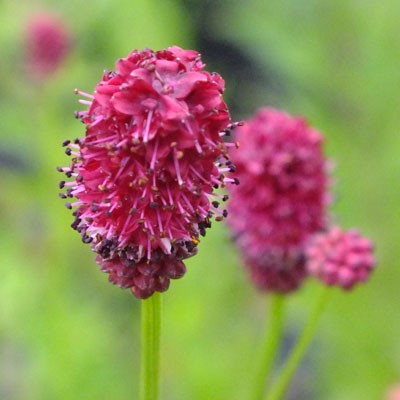
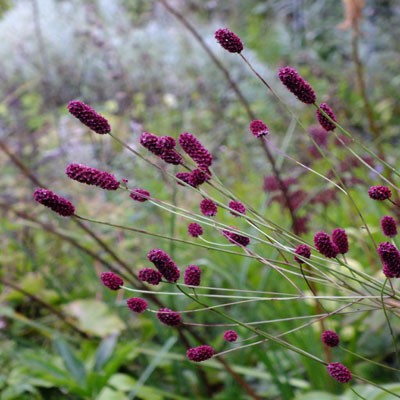
Potsize - 1L
I keep wanting to call this one 'Beaujolias' rather than 'Bordeaux', but then again after a glass or two of either what does it matter, the plant is still lovely. It sits about mid height amongst the Sanguisorbas, half way between 'Arnhem' and 'Chocolate Tip' and about in the middle for colour as well. It is a deep burgundy, (there goes another), less red than 'Arnhem' and less sombre than 'Chocolate Tip' and flowers in late summer on stiff swaying stems up to 1.5m tall.Links
Botanical Style Photographs
-
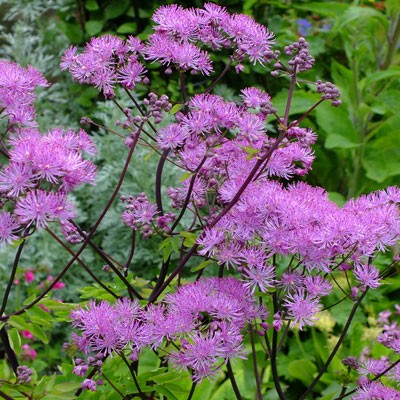
Potsize - 1L
This variety has its roots firmly in Thalictrum aquilegifolium and so has broad heads like lavender-pink fluffy clouds which are quite strong in colour and set strikingly on black stems. Plant it in a sunny spot but make sure it doesn't want for water in the growing season. 1.5m plusDiscount of 25p per plant for quantities of 3 or overLinks
Thalictrum Compared
-


Potsize - 1L
The Nimbus series are Terra Nova selections of Thalictrum aquilegifolium. They have been selected for having a relatively short height at 28 inches and an absolute abundance of stems and flowering heads. In this they are much shorter and more floriferous than Black Stockings. They have fresh green foliage and dark stems ( dark, but a little greyer than Black Stockings ). The flower heads are a pale pink, flat topped powder puff. Discount of 25p per plant for quantities of 3 or overLinks
Thalictrum Compared
-
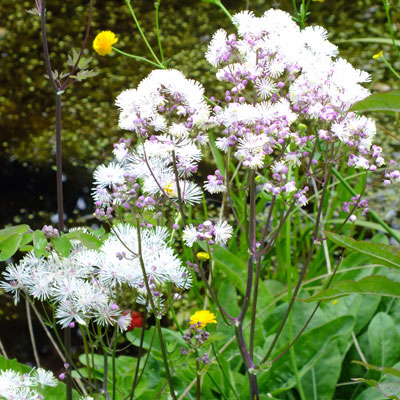
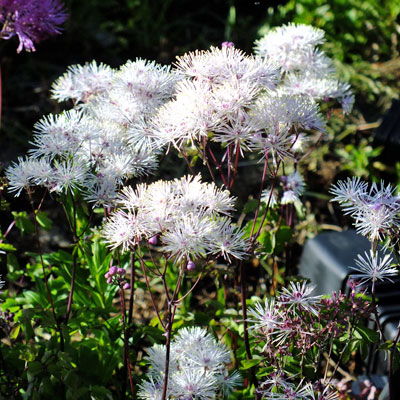
Potsize - 1L
The Nimbus series are Terra Nova selections of Thalictrum aquilegifolium. They have been selected for having a relatively short height at 28 inches and an absolute abundance of stems and flowering heads. In this they are much shorter and more floriferous than Black Stockings. They have fresh green foliage and dark stems ( dark, but a little greyer than Black Stockings ). The flower heads are a white, flat topped powder puff which are succeeded by lavender pink seed heads. Discount of 25p per plant for quantities of 3 or overLinks
Thalictrum Compared
-
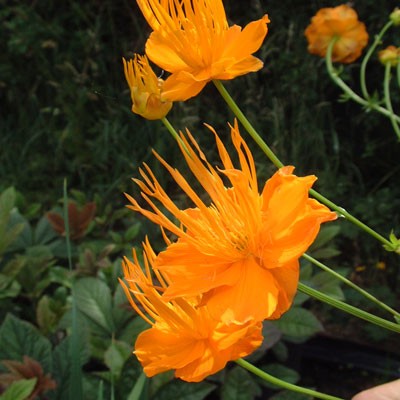
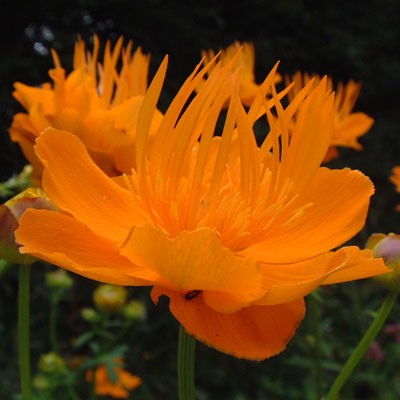

RHS AGM
Potsize - 1L
Possibly the tallest of all the Trollius, standing up to twice as tall as some of its European counterparts. The flowers stand up high and proud above the glossy dark foliage, 2 inches across, wide open with a central blazing cage of narrow petaloid segments. With the glowing orange colour it reminds me of a the Olympic cauldron in full blaze. It is a native of high rainfall areas in Northern China up through Siberia and so wants a cool constantly moist position to thrive. Reliable and hardy and excellent by a pond where it will never fail to get noticed when in flower in May. 90cm -

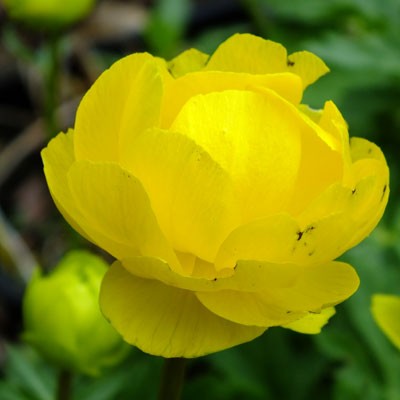
Potsize - 1L
A vigorous but compact form of our native Globeflower introduced by Jelitto in 2010. It grows about half the height of the species, but like it has lovely clear lemon yellow flowers produced freely in Spring. 30cm. Whilst Trollius will grow in the open border, they only produce their best when given access to moisture at all times. They are best suited to the edges of ponds where the roots can seek out water.Discount of 25p per plant for quantities of 3 or over -

Potsize - 1L
Once a rarity, this large impressive fern from North America is now much more commonly seen. It comes form the Western Coastal region of North America, from British Columbia right down to California. The relatively narrow fronds are held mostly erect and will reach about a metre in length. In the wild they can reach 2m (even reports of 3m) but in our climate 1m is more realistic. To get the very best, Woodwardia fimbriata would prefer a moist soil, moist atmosphere with warm Summers and mild Winters. Give it time as well as it is slow to settle and increase, but the wait and patience will be worth it as it is a most impressive fern. Cold tolerance should go down to about -10C. Unlike some Woodwardia the new growth of this species is green and it also lacks the bulbils that some species carry. -
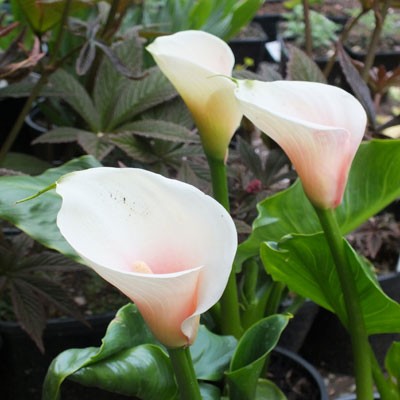

Potsize - 1L
This is a relatively new cultivar which has come from New Zealand. The flowers are more upward facing than the standard Zantedeschia, slightly shorter and posses a lovely carmine glow to the base. In shape they tend more towards a Calla lily, more funnel shaped with less of a broad flare. Reports are that it is as hardy as Green Goddess, which we have had outside for many years, and that it will take a little more dryness than usual. Like all Zantedeschis it is best to cover younger plants with a generous mulch until they are well established. 60cm -

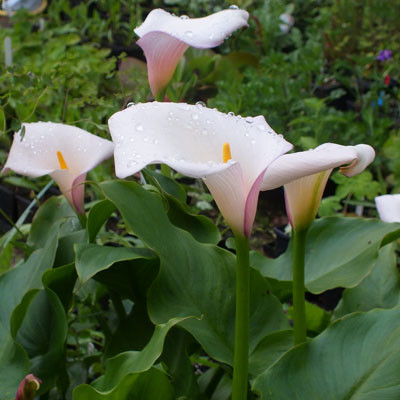
Potsize - 1L
We're a bit confused over this one. We bought this plant in micropropagated several years ago as Zantedeschia 'Flamingo', but is less fully pink than we expected. We are not sure if it was supposed to be the plant bred in the Netherlands by The Klaver Brothers, Theo and Kees for the cut flower trade, or another cultivar which vies for the name. Whichever, believe the pictures which show the plant that we have. It has the beautiful chalice form of Zantedeschia but coloured with a lovely soft sugar pink, especially on the outside. It is a vigorous grower that will bloom freely once established and cut beautifully (cut it as the bud opens). 80cm. For a warm sunny spot with access to plenty of moisture. The crowns are best protected with a deep mulch in the early years and otherwise if Winters turn very cold.

















































